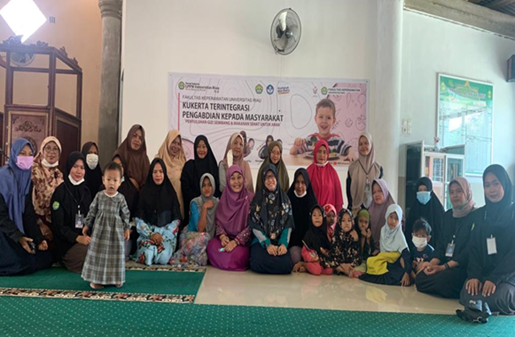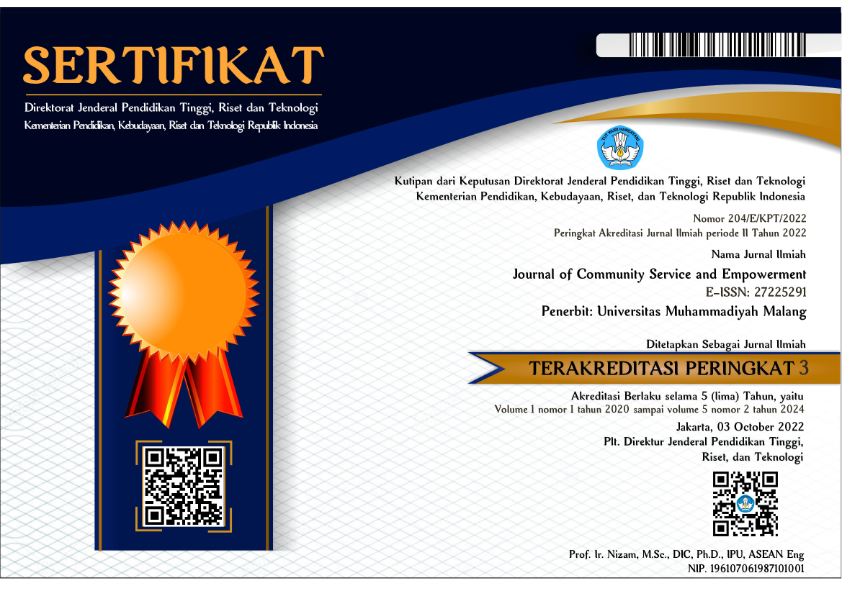Training on preparation of balanced nutrition and healthy food creativity to increase nutrition intake of school children during the Covid-19 pandemic
-
DOI:
https://doi.org/10.22219/jcse.v4i2.26287Keywords:
education, training, nutrition, school-aged childrenAbstract
The school aged students are vulnerable people to have nutritional problems particularly in this Covid 19-Pandemic era. This pandemic put children on the risk of nutritional problems, both malnutrition and obesity. Mothers are the closest person who have important role in providing childlren's diet. Therefore, the purpose of this community service’s program is to increase the knowledge and attitude of mothers in providing menu that meets nutritional balance for school-age children. The target of the program was the women of Kualu village, Tambang district, Riau Province with school-age children. The method used in this program were the provision of nutrition education based through counseling/lectures, training and demonstration. The results of the program showed that the level of mother’s' knowledge increased to 10.37 and 19.88 points. Furthermore, the mothers' creativity in providing the balanced diet also improved. The training also stimulated mothers to find new menus which mainly ingredients come from surrounding environment that meet nutrions need among school aged children. Therefore, the nutrition education program has been proved effective in increasing mothers' knowledge and creativity. Hence this program can be used as an additional program in Posyandu to optimize children nutritional status.
Downloads
References
Ares, G., Bove, I., Vidal, L., Brunet, G., Fuletti, D., Arroyo, Á., & Blanc, M. V. (2021). (2020). The experience of social distancing for families with children and adolescents during the coronavirus (COVID-19) pandemic in Uruguay: Difficulties and opportunities, (January).
Asakura, K., Mori, S., Sasaki, S., & Nishiwaki, Y. (2021). A school-based nutrition education program involving children and their guardians in Japan: facilitation of guardian-child communication and reduction of nutrition knowledge disparity. Nutrition Journal, 20(1), 1–13. https://doi.org/10.1186/s12937-021-00751-z
Blodgett, C., & Lanigan, J. D. (2018). The association between adverse childhood experience (ACE) and school success in elementary school children. School Psychology Quarterly, 33(1), 137–146. https://doi.org/10.1037/spq0000256
Buchanan, D., Hargreaves, E., & Quick, L. (2022). Schools closed during the pandemic: revelations about the well-being of ‘lower-attaining’ primary-school children. Education 3-13, 0(0), 1–14. https://doi.org/10.1080/03004279.2022.2043405
Fadare O, Amare M, Mavrotas G, Akerele D, & Ogunniyi A. (2019). Mother’s nutrition-related knowledge and child nutrition outcomes: Empirical evidence from Nigeria. PLoS ONE, 14, 1–17.
Headey, D., Heidkamp, R., Osendarp, S., Ruel, M., Scott, N., Black, R., … Walker, N. (2020). Impacts of COVID-19 on childhood malnutrition and nutrition-related mortality. The Lancet, 396(10250), 519–521. https://doi.org/10.1016/S0140-6736(20)31647-0
Hosseinzadeh, P. (2022). Consequences of the COVID-19 Pandemic . A Systematic Review S ocial, 40(1).
Huda, N, & Safri. (2016). Relationships nutrition behavior to nutrition status of school age children in Meranti Island , Riau Province, 516–525.
Huda, Nurul. (2016). Family Support Relationships with school age Children ’ s Nutritional Status at Meranti Island , Riau Province, 440–451.
Iklima, N. (2017). Gambaran Pemilihan Makanan Jajanan Pada Anak Usia Sekolah Dasar. Jurnal Keperawatan BSI, 5(1), 8–17. Retrieved from https://ejournal.bsi.ac.id/ejurnal/index.php/jk/article/view/1774/1389
Kokaji, N., & Nakatani, M. (2021). With a Hint of Sudachi: Food Plating Can Facilitate the Fondness of Food. Frontiers in Psychology, 12(October), 1–10. https://doi.org/10.3389/fpsyg.2021.699218
Lamping, B. G. (2023). Qualitative Study on Preschool Children Parents/Guardians’ Diet during COVID-19 Pandemic. Doctoral Dissertation, The Catholic University of America, 4(1), 88–100.
Lange, S. J., Kompaniyets, L., Freedman, D. S., ; Emily M. Kraus, PhD2; Renee Porter, D., & Heidi M. Blanck, PhD1; Alyson B. Goodman, M. (2021). Longitudinal Trends in Body Mass Index Before and During the COVID-19 Pandemic Among Persons Aged 2–19 Years — United States, 2018–2020. MMWR. Morbidity and Mortality Weekly Report, 70(37), 1278–1283. https://doi.org/10.15585/mmwr.mm7037a3
Nathan, N., Janssen, L., Sutherland, R., Hodder, R. K., Evans, C. E. L., Booth, D., … Wolfenden, L. (2019). The effectiveness of lunchbox interventions on improving the foods and beverages packed and consumed by children at centre-based care or school: A systematic review and meta-analysis. International Journal of Behavioral Nutrition and Physical Activity, 16(1), 1–15. https://doi.org/10.1186/s12966-019-0798-1
Nugraha, N. P., Ilmi, A. A., & Patima, P. (2021). Metode Edukasi Gizi Berbasis Komunitas Pada Anak Usia Sekolah:Telaah Literatur. Alauddin Scientific Journal of Nursing, 2(2), 118–134. https://doi.org/10.24252/asjn.v2i1.23678
Onoja, U. S., Iloeje, I. C., Onoja, N. C., & Uzor, P. F. (2019). Nutritional Status of Adolescent Schoolchildren In South East Nigeria. Pakistan Journal of Nutrition, 18(9), 845–851. https://doi.org/10.3923/pjn.2019.845.851
Pietrobelli, A., Pecoraro, L., Ferruzzi, A., Heo, M., Faith, M., Zoller, T., … Heymsfield, S. B. (2020). Effects of COVID-19 Lockdown on Lifestyle Behaviors in Children with Obesity Living in Verona, Italy: A Longitudinal Study. Obesity, 28(8), 1382–1385. https://doi.org/10.1002/oby.22861
Popkin, B. M., Adair, Li. S., & Ng, S. W. (2017). NOW AND THEN: The Global Nutrition Transition: The Pandemic of Obesity in Developing Countries. Nutrients, 58(1), 1–10. https://doi.org/10.1111/j.1753-4887.2011.00456.x.NOW
Rahadiyanti, A., Salma Dina, S., Putri, S., Tampubolon, O., Yeshi Veicinlun, S., Mattarahmawati, S. A., … Ningsih, S. (2022). Peningkatan Pengetahuan Ibu dan Guru Terkait Gizi Seimbang Anak Usia 5-8 Tahun di Sekolah Al-Hunafa Kota Bandung. Jurnal Proactive, 1(1), 8–14. Retrieved from https://ejournal2.undip.ac.id/index.php/proactive
Razi, M., & Nasiri, A. (2022). Concerns of parents about children’s overweight and obesity during the COVID-19 pandemic: A qualitative study. Journal of Pediatric Nursing, 63, 111–116. https://doi.org/10.1016/j.pedn.2021.11.012
Ruiz-Roso, M. B., Padilha, P. de C., Mantilla-Escalante, D. C., Ulloa, N., Brun, P., Acevedo-Correa, D., … Dávalos, A. (2020). Changes of Physical Activity and Ultra-Processed Food Consumption in Adolescents from Di ff erent. Nutrients, 12(2289), 1–13.
Sandi Wachyuni, S., & Wiweka, K. (2020). the Changes in Food Consumption Behavior: a Rapid Observational Study of Covid-19 Pandemic. International Journal of Management, Innovation & Entrepreneurial Research, 6(2), 77–87. https://doi.org/10.18510/ijmier.2020.628
Sanyaolu, A., Okorie, C., Qi, X., Locke, J., & Rehman, S. (2019). Childhood and Adolescent Obesity in the United States: A Public Health Concern. Global Pediatric Health, 6. https://doi.org/10.1177/2333794X19891305
Saragih, L., Hasanah, O., & Huda, N. (2015). Hubungan sarapan pagi dan aspek biologis pada anak usia sekolah. Journal Online Mahasiswa Universitas Riau, 2. https://doi.org/10.35681/1560-9189.2015.17.3.100328
Schuster, A. R. C., Szpak, M., Klein, E., Sklar, K., & Katherine, L. (2019). “ I try , I do ”: Child feeding practices of motivated , low-income parents reflect trade-offs between psychosocial and nutrition goals Center for Global Health , School of Human Evolution and Social Change , Arizona State Division of Nutritional Sciences , Cornell University , Ithaca , NY * Corresponding Author Roseanne Schuster Center for Global Health , School of Human Evolution and Social Change , Arizona State University , Tempe , AZ PO Box 872402 Tempe , AZ 875287-2402.
Sharma, S. V., Chuang, R. J., Rushing, M., Naylor, B., Ranjit, N., Pomeroy, M., & Markham, C. (2020). Social Determinants of Health–Related Needs During COVID-19 Among Low-Income Households With Children. Preventing Chronic Disease, 17, 1–12. https://doi.org/10.5888/pcd17.200322
Story, M., Kaphingst, K. M., & French, S. (2006). The role of child care settings in obesity prevention. Future of Children, 16(1), 143–168. https://doi.org/10.1353/foc.2006.0010
Sukandar, D., Khomsan, A., Anwar, F., Riyadi, H., & Mudjajanto, E. (2015). Nutrition Knowledge, Attitude, and Practice of Mothers and Children Nutritional Status Improved after Five Months Nutrition Education Intervention. International Journal of Sciences: Basic and Applied Research (IJSBAR) International Journal of Sciences: Basic and Applied Research, 23(2), 424–442. Retrieved from https://gssrr.org/index.php/JournalOfBasicAndApplied/article/view/4336/2406
Sum, K. K., Cai, S., Law, E., Cheon, B., Tan, G., Loo, E., … Huang, J. (2022). COVID-19-Related Life Experiences, Outdoor Play, and Long-term Adiposity Changes among Preschool-and School-Aged Children in Singapore 1 Year after Lockdown. JAMA Pediatrics, 176(3), 280–289. https://doi.org/10.1001/jamapediatrics.2021.5585
Zemrani, B., Gehri, M., Masserey, E., Knob, C., & Pellaton, R. (2021). A hidden side of the COVID-19 pandemic in children: the double burden of undernutrition and overnutrition. International Journal for Equity in Health, 20(1), 1–4. https://doi.org/10.1186/s12939-021-01390-w

Downloads
Published
How to Cite
Issue
Section
License
Copyright (c) 2023 Nurul Huda, Rismadefi Woferst, E. Erwin, Eka Febriyanti

This work is licensed under a Creative Commons Attribution-ShareAlike 4.0 International License.












